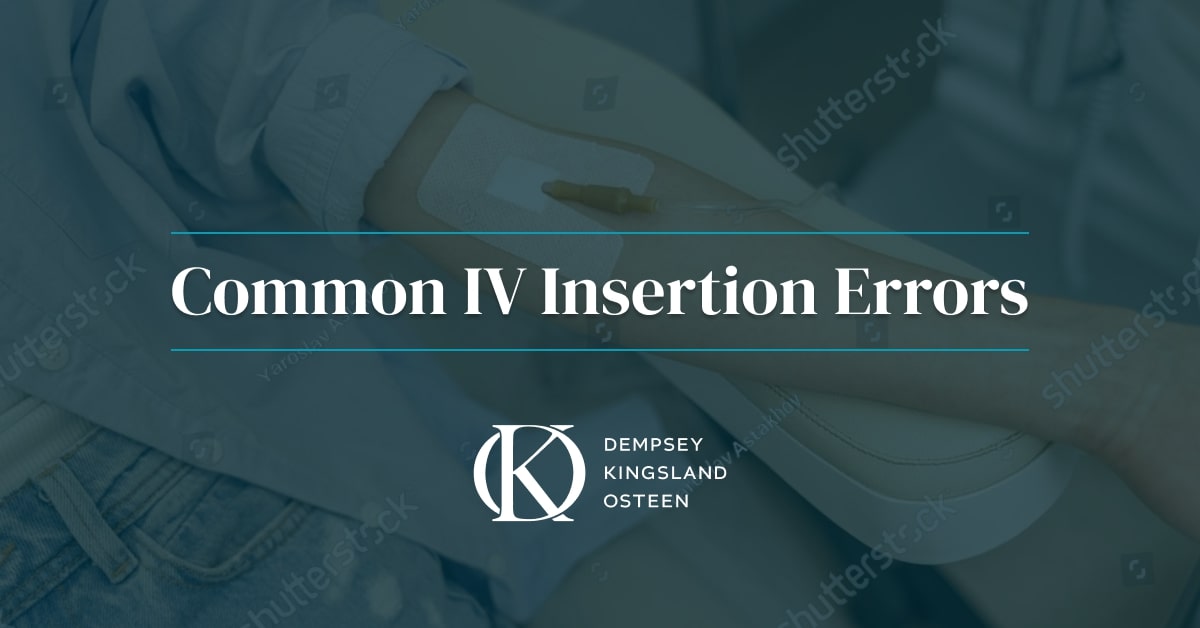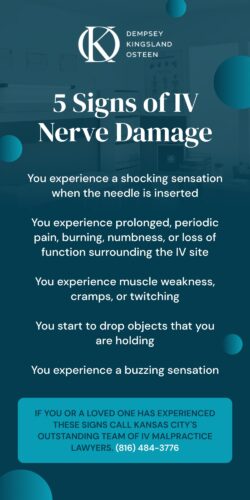
Whenever we’re hospitalized, we put our faith in the doctors, nurses, and staff to take good care of us while we’re vulnerable and in pain. However, even skilled professionals can make mistakes, such as common IV insertion errors, which can lead to complications and discomfort.
One of the common features of being hospitalized is receiving fluids or medicines through an IV. It’s so common we barely think about whether it could be dangerous, but there is such a thing as a bad IV stick.
If you have been injured from a bad IV stick contact our experienced IV Malpractice Lawyers today. We have won millions for our clients and want to hear about your case.
Can a Bad IV Cause Nerve Damage?
In the event that an intravenous (IV) catheter penetrates a nerve, it can cause temporary or permanent nerve damage.
Following an injury, the nerve will attempt to regenerate; however, recovery is not always possible. IV nerve damage can take anywhere from a few weeks to years to subside, if at all.
How do you know if you have IV nerve damage? See below:
- You experience a shocking sensation when the needle is inserted
- You experience prolonged, periodic pain, burning, numbness, or loss of function surrounding the IV site
- You experience muscle weakness, cramps, or twitching
- You start to drop objects that you are holding
- You experience a buzzing sensation
You can determine if an IV is in the wrong place by observing signs such as intense swelling and noticeable bruising.
These symptoms are indicative of IV infiltration, a condition where fluids or medications are mistakenly delivered into the surrounding tissue instead of the intended vein.
What Happens If IV Is Not in Vein?
Fluid collects around the I.V. site instead of remaining in the blood vessel, causing tissue damage and preventing proper delivery of medicine or fluid into the bloodstream.
Additionally, the intended medicine or fluids won’t reach the bloodstream, leading to ineffective treatment. This is called IV infiltration, and it can cause harm ranging from irritation to fluid overload, infections, nerve damage, stroke, brain injury, or even death.
When an intravenous (IV) injection is not properly administered into a vein, the injected fluids may escape into the surrounding tissues instead of remaining within the bloodstream.
This can lead to localized swelling and tissue damage at the site of the IV insertion. It’s essential to ensure that IVs are correctly placed in veins to prevent these complications and ensure the safe delivery of fluids or medications.
Certain medications require special care when administered by IV because they are irritating or even corrosive. Infiltration of these medications into tissue surrounding an IV can cause second or third-degree burns, permanent scarring, and injuries serious enough to require amputation.
Ready to schedule a free consultation with our Kansas City medical malpractice lawyers?.
contact usMisconceptions About the Proper Administration of IV Therapy
Unfortunately, misconceptions about the proper administration of IV therapy are all too common. For example, the Food and Drug Administration frequently receives mistaken IV pump malfunction reports complaining that an IV pump’s downstream occlusion alarm wasn’t triggered by infiltration.
The numerous false reports prompted the FDA to issue a reminder to doctors and hospitals that those alarms aren’t even meant to detect tissue infiltration.
Common Errors that Cause IV Infiltration
According to the CDC’s 2011 guidelines for the prevention of intravascular catheter-related infections, some common errors by hospitals and medical staff that can cause IV infiltration or related complications include:
- Failure to evaluate the insertion site daily for signs of irritation or infiltration.
- Failure to immediately remove the IV when infiltration is detected.
- Using steel IV needles when administering certain medications and fluids that can cause tissue death if they should infiltrate tissue.
- Choosing the wrong IV location.
- Neglecting to promptly replace IV catheters that were inserted during emergencies when sterile conditions could not be ensured, or to remove those no longer essential.
By avoiding these common IV insertion errors and following best practices, healthcare professionals can ensure safer and more effective IV access for patients.
Common IV Insertion Errors: Avoid These Mistakes
Catheter Length:
- Mistake: Using a catheter that is too short.
- Solution: Ensure the catheter length is appropriate for the patient’s vein and the intended purpose. Using a catheter that is too short can lead to complications and discomfort during IV therapy.
Needle and Catheter Depth:
- Mistake: Failing to insert the needle and catheter deep enough into the vein.
- Solution: Properly assess the depth of the vein and insert the needle and catheter to the correct depth. Shallow insertion may result in infiltration or dislodgment of the IV line.
Needle Insertion Angle:
- Mistake: Inserting the needle at too steep an angle.
- Solution: Maintain the correct angle of insertion, typically around 15-30 degrees, to avoid complications like puncturing through the vein or causing unnecessary discomfort to the patient.
Injured By A Bad IV Stick? Contact Dempsey Kingsland Osteen Now
It all beings with a call. When speaking with our malpractice attorneys we can help you determine if you have an IV malpractice case or not. If you were injured by a bad iv stick you should call experienced Kansas City IV malpractice lawyers today.
It’s shocking that misconceptions and errors persist when IV therapy is so common. Ideally, IV infiltration shouldn’t happen, and it certainly shouldn’t be allowed to persist for more than 24 hours.
It’s an enormous tragedy that anyone should be seriously harmed or a life lost due to such an easily avoidable hospital error, but it does happen, and we know how to prove medical negligence.
If you or a loved one has been harmed by an IV error, you have the right to answers — and justice. Turn to the medical malpractice attorneys at Dempsey Kingsland Osteen for the guidance you deserve. Contact us today.
If you or someone you love was injured due to an IV improperly inserted, call Dempsey Kingsland Osteen at (816) 484-3776 or contact us via online form. Your initial consultation with our medical malpractice lawyers is free of charge.





